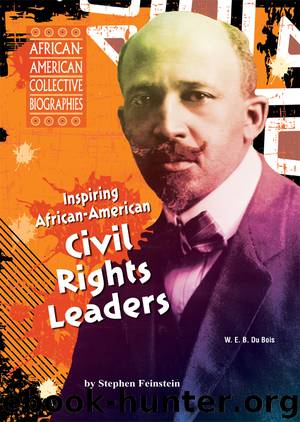Inspiring African-American Civil Rights Leaders by Stephen Feinstein

Author:Stephen Feinstein [Feinstein, Stephen]
Language: eng
Format: epub
ISBN: 978-1-4645-0942-1
Publisher: Enslow Publishers, Inc.
Published: 2013-03-14T16:00:00+00:00
Malcolm, one of life’s first needs is for us to be realistic.…A lawyer—that’s no realistic goal for a nigger. You need to think about something you can be. You’re good with your hands—making things. Everybody admires your carpentry shop work. Why don’t you plan on carpentry? People like you as a person—you’d get all kinds of work.1
Malcolm was stunned. He had believed that Mr. Ostrowski liked him. Now Malcolm suddenly understood that even well-meaning white people held racist notions regarding African Americans. In the eyes of whites, he would always be a second-class citizen. It was a bitter lesson, one that Malcolm would never forget.
Malcolm Little was born on May 19, 1925, to Earl and Louise Little in Omaha, Nebraska. Malcolm was the fourth of the Littles’ seven children (Earl, an itinerant minster and construction worker, also had three other children from a previous marriage, who lived in Boston). Shortly after Malcolm was born, the family moved to Milwaukee. They stayed there briefly and then moved on to Lansing, Michigan.
Louise later told Malcolm about a frightful event that occurred in Omaha when she was pregnant with him. One night, a group of hooded Ku Klux Klan riders on horseback armed with shotguns and rifles surrounded the house. They demanded to speak to Earl. Apparently they were angry that Earl, a Baptist preacher, had been spreading the ideas of Marcus Garvey. Garvey had been speaking out about how African Americans could improve their lives, and he was urging African Americans to move to Africa. When a terrified Louise told them Earl was not home, the Klansmen warned the Littles that they had better get out of town. Then the Klansmen rode off into the night, but not until they had shattered every windowpane in the house.
On November 7, 1929, the Littles’ home in Lansing was set on fire during the night. Earl Little fired shots at the two white men who had set the fire and were running away. When the white police and firemen arrived, they just stood around and watched as the house burned to the ground. The Little family next moved to East Lansing, where Earl, with his own hands, built a four-room house in the country about two miles outside of town. This was the home in which Malcolm grew up.
One day in September 1931, tragedy struck. Earl Little was killed in an accident, crushed to death by a trolley. There were rumors that Earl had been killed first and his body placed on the trolley tracks. He had made enemies by speaking up for the rights of African Americans. Life now became difficult for Louise Little and her children. The country was in the midst of the Great Depression, and there were many days when the Littles went hungry. By 1937 it became clear that Louise was drifting toward insanity and could no longer support the family. Social workers sent the children to live in different foster homes. Louise Little spent twenty-six years in a mental hospital in Kalamazoo, Michigan.
Download
This site does not store any files on its server. We only index and link to content provided by other sites. Please contact the content providers to delete copyright contents if any and email us, we'll remove relevant links or contents immediately.
| Anthropology | Archaeology |
| Philosophy | Politics & Government |
| Social Sciences | Sociology |
| Women's Studies |
The Secret History by Donna Tartt(18840)
The Social Justice Warrior Handbook by Lisa De Pasquale(12141)
Thirteen Reasons Why by Jay Asher(8792)
This Is How You Lose Her by Junot Diaz(6786)
Weapons of Math Destruction by Cathy O'Neil(6142)
Zero to One by Peter Thiel(5684)
Beartown by Fredrik Backman(5594)
The Myth of the Strong Leader by Archie Brown(5424)
The Fire Next Time by James Baldwin(5248)
How Democracies Die by Steven Levitsky & Daniel Ziblatt(5127)
Promise Me, Dad by Joe Biden(5087)
Stone's Rules by Roger Stone(5026)
A Higher Loyalty: Truth, Lies, and Leadership by James Comey(4842)
100 Deadly Skills by Clint Emerson(4840)
Rise and Kill First by Ronen Bergman(4701)
Secrecy World by Jake Bernstein(4643)
The David Icke Guide to the Global Conspiracy (and how to end it) by David Icke(4624)
The Farm by Tom Rob Smith(4434)
The Doomsday Machine by Daniel Ellsberg(4415)
